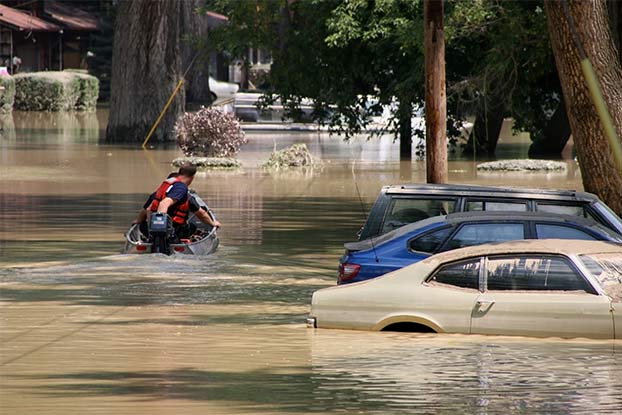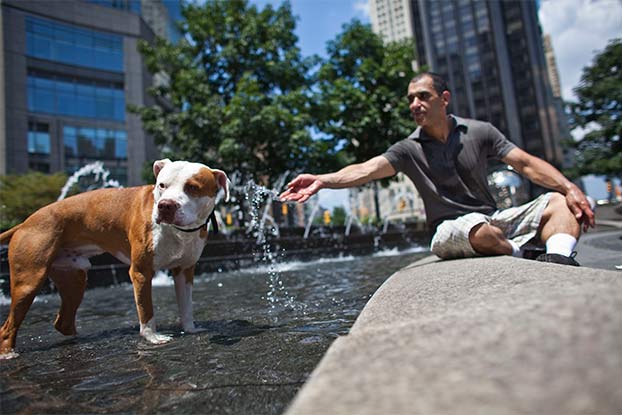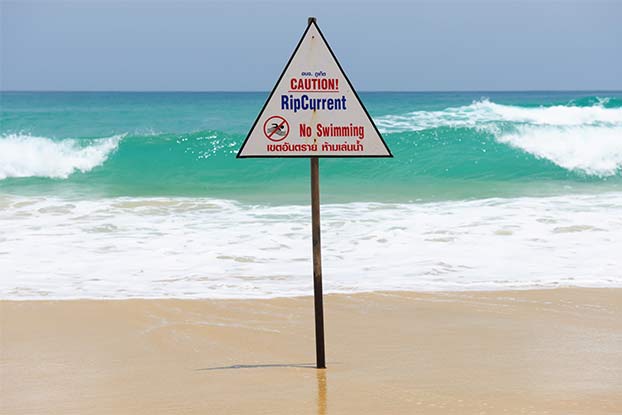7.洪水
The best way to react to a severe flood situation is to do the exact opposite of what you would do in a tornado. In other words, seek the highest possible ground.
我們在面臨洪水時(shí)所采取的最佳方案與我們面臨龍卷風(fēng)時(shí)所采取的方案恰恰是相反的。也就是說,當(dāng)洪水來了的時(shí)候,我們要盡可能的尋找地勢較高的地方。
The inclination to run -- or drive -- away from rising flood waters is understandable, but it's also dangerous. As little as 6 inches (15 centimeters) of rising water can be enough to sweep a person off of his or her feet, while just 18 inches (46 centimeters) of rising water can carry a vehicle away.
看到身邊的水位急速上漲,一般人都會想快點(diǎn)逃離該處,這種想法是可以理解的,但其中也存在著一定的安全隱患。水位上漲6英寸(15厘米)就可以淹沒一個(gè)人的腳,上漲18英寸(46厘米)則可以使汽車移位。

Downed power lines from a hurricane or tsunami can still be live, leaving you one false move from being lit up like a firecracker on the Fourth of July. Hopping behind the wheel also poses its own set of hazards. Floodwaters may hide debris, potholes and other damage that could make roads impassable. If your car stalls, abandon it immediately and head for high ground.
暴風(fēng)、海嘯所致的斷裂高壓線有可能依舊帶電,你不小心踏錯一步,就可能像美國獨(dú)立日要放的煙火一樣被點(diǎn)燃。另外,開車逃跑也是件冒險(xiǎn)的事,洪水會將物品殘骸、路面上的坑坑洼洼,以及其他可能導(dǎo)致危險(xiǎn)的事物全部掩蓋起來,使得道路無法正常通行。如果你的車熄火了,這時(shí)你最好選擇棄車并盡快跑到地勢較高的地方。
6.惡犬

Perhaps the best cure for a shy bladder is the sight of an aggressive dog barreling toward you at full tilt. If that doesn't make you question every decision you've made in your life, probably nothing will.
當(dāng)一個(gè)人被一條咆哮著的狗狂追不止的時(shí)候,他可能會產(chǎn)生“完了完了!要被咬死了!”的想法。人面臨死亡的瞬間大腦會飛速運(yùn)作,幾乎把一生都反思一遍,好多東西也會看開,這可能也是為什么會有“人之將死其言也善”的現(xiàn)象。
Though many people think certain breeds (like pit bulls and Rottweilers) are more aggressive than others, any dog can turn angry if surprised or threatened. A study of dog bite statistics from the 1980s to 2000s didn’t show any breed as being more dangerous than another. Whichever breeds happened to be most popular in a given period were the ones that showed up for most dog bites in that period.
盡管許多人會認(rèn)為某些特定品種的狗,就像是比特犬(pit bull)和羅特韋爾犬(Rottweiler)之類的,比起其他類型的狗更為兇惡。其實(shí)一旦受到驚嚇,任何種類的狗都會分分鐘發(fā)怒,變成“惡犬”。一項(xiàng)研究統(tǒng)計(jì)了從20世紀(jì)80年代到21世紀(jì)初被狗咬傷的人口數(shù)量,數(shù)據(jù)表明,所有的狗其實(shí)都很危險(xiǎn)。在某個(gè)特定時(shí)期最常見的那種狗往往會被認(rèn)為是咬傷人的始作俑者。
What everyone agrees is that a person faced with a threatening canine shouldn't try to run away. Doing so may simply provoke the animal to attack. Plus, you're not going to be able to outrun it. Instead, cover your eyes and stand still. (Dogs take staring as a challenge; also, you'll want to protect your face). Try not to make any noise. Hopefully, the dog will take you for a tree or log and leave you alone.
當(dāng)我們面對惡狗的威脅時(shí),不應(yīng)該試圖逃跑,這樣做只會激怒它來攻擊自己,而且我們也不可能跑得過它。相反的,我們應(yīng)該站在原地并蒙住自己的眼睛,這時(shí)狗狗會感到奇怪,于是選擇靜觀其變而非貿(mào)貿(mào)然上前進(jìn)行攻擊,同時(shí)這個(gè)動作也能保護(hù)我們的臉部。盡量不要發(fā)出任何聲音,這時(shí)候,狗狗很可能就會把我們當(dāng)作是一棵樹或是木頭,并失去所有的興趣,然后就溜走了。
5.離岸流

Most people won't actually try to run away from a rip current; they probably hope to outswim it. An unexpectedly strong current that forms at low spots or breaks in a sandbar, a rip current can move at a speed of up to 8 feet (2.4 meters) per second. Swimming toward shore might be your first move when a leisurely dip in the ocean is threatened by a powerful current channel, but it could also be your last.
事實(shí)上很多人遭遇離岸流(rip current)時(shí)不會想著要避開,而是希望能和這股水流一決高下。離岸流通常因低壓產(chǎn)生的臺風(fēng)或是水流沖破海底的沙洲(sandbar)而形成,其速度可達(dá)到8英尺(2.4米)每秒。當(dāng)你悠閑地在大海中盡情嬉戲時(shí),不巧碰到這股強(qiáng)大的水流,你的第一個(gè)念頭可能是快點(diǎn)游上岸,然而如果這樣做了,這個(gè)“第一個(gè)念頭”就可能會成為你的最后一個(gè)念頭。
Experts say that the currents are tough to outswim, and those who try to do so may become fatigued (and risk drowning) before reaching dry land. Instead, swim parallel to the riptide. It's likely to be less than 100 feet (30 meters) wide. If that doesn't work, lie flat on your back and let the current take you away from shore until you've passed beyond it. Then try swimming around it or to shore.
專家指出,人類游泳的速度很難跟上離岸流的流速,縱使拼盡全力,有片刻時(shí)間領(lǐng)先了離岸流,也無法到達(dá)彼岸,因?yàn)樵谀侵拔覀兊牧饩鸵押谋M并處于瀕臨溺死的危險(xiǎn)狀態(tài)。所以遇到離岸流,我們應(yīng)該做的是,平行于這股激流游動,直到繞開離岸流,這樣才有生存的可能。一般而言,離岸流的寬度小于100英尺(30米),因此,就算是那些無法繞開水流或水性不佳的人,只需要平躺在海面上,隨之流動,等到漂離了激流的范圍后再嘗試游回海岸。
4.地震

As in all the other emergency scenarios we've gone through so far, it's important to remain calm when the earth starts a-shakin'. If you're indoors, get away from windows, drop under a sturdy table, desk or other protective area and cover your head with a pillow. Failing that, go to an interior wall in the house and protect your head with a pillow.
和以上遇到的突發(fā)情況一樣,遇到地震時(shí)一定要保持冷靜。如果你在室內(nèi),請務(wù)必遠(yuǎn)離窗戶,躲在牢固的桌子、凳子或其它有防護(hù)物體的區(qū)域下,并用枕頭保護(hù)你的頭部。實(shí)在不行的話,至少要貼緊墻壁,并用墊子護(hù)頭。
If you're outside, move to an open area that's away from buildings, power lines and other potential hazards that could be knocked down during an earthquake. If you're driving, get your vehicle out of traffic and park it somewhere that's also clear of trees, signs, traffic signals and light posts if possible.
如果你在戶外,請迅速轉(zhuǎn)移到空地上,遠(yuǎn)離建筑物、電源線以及其它可能在地震中震倒的危險(xiǎn)物品。如果你正在駕駛,請迅速駛離車道,盡可能找個(gè)沒有大樹、交通指示牌、紅綠燈以及燈柱的地方停靠。
Whatever you do, just don't run. Most earthquake injuries occur when people are hit by falling objects while trying to enter or exit a building.
無論你做什么,千萬別亂跑。地震中大多數(shù)的傷害就發(fā)生在人們試圖進(jìn)入或離開建筑物的瞬間,因?yàn)闀徽鹇涞奈锛覀?/p>















